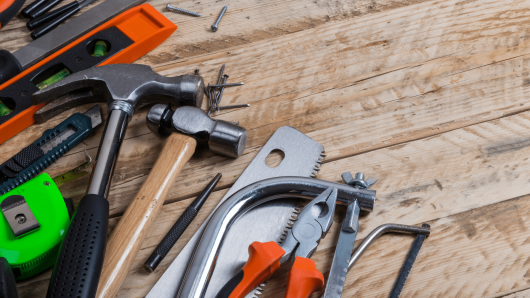Home improvement has always been one of the strongest industries, but in today’s digital landscape, the way consumers shop for tools, materials, and home renovation products is shifting. Marketplaces like Amazon, Home Depot, Lowe’s, and Wayfair are no longer just alternatives to traditional brick-and-mortar stores – they are now primary shopping destinations for several consumers. At JumpFly, we see firsthand how brands that strategically approach these platforms can unlock growth and expand their omnichannel strategy.
E-commerce marketplaces have become an essential channel for home improvement brands looking to expand their reach. The shift in consumer behavior, combined with marketplace advancements, presents several opportunities for both manufacturers and resellers. The key is understanding how to position your brand effectively and optimize your marketplace presence for growth and success.
Understanding the Home Improvement Shopper
Unlike impulse purchases in categories like fashion or electronics, home improvement shoppers often follow a more intentional buying process. These customers conduct thorough research, compare multiple products, and seek reliability before making a purchase. They rely on high-quality product images, detailed descriptions, and user reviews to guide their purchasing decision.
Additionally, convenience plays an important role. Many shoppers now prefer to order online and have products delivered directly to their homes or even pick them up at a nearby store. The rise of DIY, fueled by online tutorial videos and social media, has also expanded the customer base beyond contractors and professionals to everyday homeowners looking to handle projects themselves.
Choosing the Right Marketplaces
For brands looking to maximize their presence in the home improvement space, selecting the right marketplaces is essential. Let’s break down the top platforms and their unique strengths:
Amazon: The One-Stop Shop
As many are aware, Amazon dominates online shopping, and its presence in the home improvement industry continues to grow. With a large audience and multiple fulfillment options through FBA (Fulfilled by Amazon), brands can reach millions of potential buyers on Amazon. Some key strategies for success on Amazon include:
- Optimizing product listings with high-quality images, detailed descriptions, and strategic keywords.
- Leveraging Amazon Ads (Sponsored Products, Sponsored Brands, and Sponsored Display ads) to increase visibility.
- Managing inventory smartly to maintain in-stock status and leverage Prime shipping.
- Encouraging customer reviews to build trust and improve conversion rates.
Home Depot & Lowe’s: The Home Improvement Powerhouses
Both Home Depot and Lowe’s have developed e-commerce platforms that integrate with their physical stores. These marketplaces attract professional contractors as well as DIY enthusiasts. Selling here requires a strong understanding of the following:
- Pricing competitiveness, as these platforms cater to bulk buyers and professional contractors.
- Product detail page optimization, ensuring specifications are clear and aligned with industry standards.
- Local store availability strategies, as many customers prefer buying online and picking up in-store.
Wayfair: The Home Goods Specialist
While Wayfair is primarily known for home decor and furniture, it also offers opportunities for home improvement brands, especially in lighting, plumbing fixtures, and cabinetry. Success on Wayfair involves:
- Tailoring product offerings to fit home renovation projects rather than general hardware needs.
- Investing in lifestyle imagery, as Wayfair’s audience responds well to visually appealing product images.
- Utilizing Wayfair’s marketing programs to boost visibility within relevant categories.
5 Key Strategies for Success in Home Improvement Marketplaces
Once you’ve selected the right marketplaces, the next step is implementing a data-driven strategy to drive growth. Here are some of the critical areas to focus on:
1. Optimize Listings for SEO & Conversions
Marketplace search engines operate on algorithms that prioritize relevance and engagement. Brands must ensure that product titles, descriptions, and bullet points are optimized with the following:
- Relevant keywords that match shopper search terms.
- Clear product specifications, dimensions, and use cases.
- High-resolution images that showcase the product in use.
- Enhanced content such as A+ Content (Amazon) and strong product descriptions.
2. Invest in Advertising & Promotions
Paid advertising is a key piece for gaining visibility in competitive categories. Each marketplace offers its own advertising solutions, including:
- Amazon Sponsored Ads to target high-intent shoppers.
- Home Depot’s Retail Media+ for increased placement opportunities.
- Lowe’s Sponsored Products to drive conversion.
- Wayfair’s Sponsored Products, Sponsored Shops, and frequent event promotions.
Running seasonal promotions, offering bundles, and utilizing marketplace deal programs can also attract price-sensitive shoppers.
3. Maintain Competitive Pricing & Inventory Management
Price sensitivity is important in home improvement, especially among professional buyers. Brands need to:
- Monitor competitors and adjust pricing strategies accordingly.
- Take advantage of dynamic pricing tools to remain competitive.
- Ensure strong inventory management to prevent stockouts and delays.
4. Enhance Customer Engagement & Reviews
Home improvement products often require installation or DIY assembly. Ensuring a smooth customer experience is crucial to earning positive reviews and brand loyalty. This includes:
- Providing detailed installation guides and how-to videos.
- Actively responding to customer inquiries and reviews.
- Offering warranties or guarantees to build buyer confidence.
5. Leverage Data for Continuous Improvement
Analyzing marketplace data allows brands to refine their strategies. Key metrics to track include:
- Conversion rates to assess listing effectiveness.
- Ad performance to optimize spend and targeting.
- Customer feedback to identify areas for improvement.
The Future of Home Improvement Marketplaces
As e-commerce continues to evolve, so will the home improvement industry. Emerging trends such as augmented reality for visualizing projects, AI-driven customer recommendations, and same-day delivery services will continue to shape the future of these marketplaces.
For brands willing to invest in an omnichannel approach, the opportunity is clear. The key is staying adaptable, data-driven, and customer-focused.








